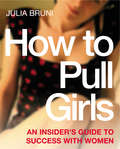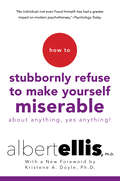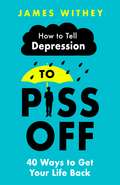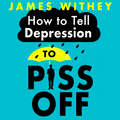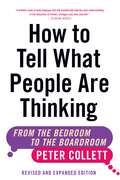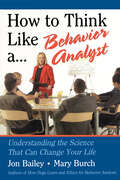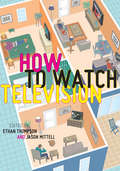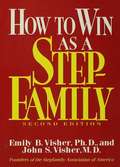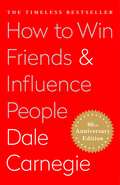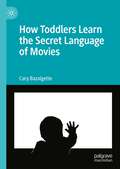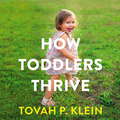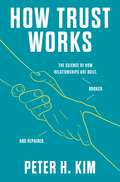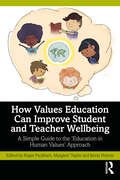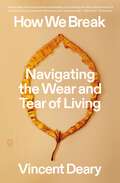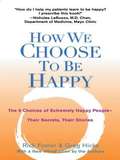- Table View
- List View
How To Pass Psychometric Tests: This book gives you information, confidence and plenty of practice
by Andrea ShavickIn this book, author Andrea Shavick explains all there is to know about psychometric tests: what they are, what they measure, who uses them, why they're used, how they're changing, how to survive them, and even how to avoid them altogether! It includes 35 different, genuine, practice test from SHL Group pls, the world's biggest test publisher. It has 265 questions covering verbal, numerical, abstract and spatial reasoning; mechanical comprehension; fault diagnosis; acutness and personlaity. This book gives you the information, confidence and practice to pass psychometric tests.
How To Pull Girls: An Insider Guide To Success With Women
by Julia BruniFor many men, changes in society have made it harder to get to know women and pulling has become more difficult than it's ever been. The result is that many capable and otherwise successful young men feel frustrated by not having a girlfriend - or even a lay. How to Pull Girls gives the lowdown on how to meet and charm girls. Whether you need to relax and set women at ease, or to understand how girls think and what motivates them, Julia Bruni has all the insider information, analysing the pulling game from every angle. How to Pull Girls is packed full with useful strategies and techniques for every stage of the women-charming mission and will transform you from a Mr Normal to a James Bond in a matter of minutes. This is the essential pulling tool kit 'Women, be warned. Julia's on their side and she is telling them our secrets!'' Kathy Lette
How To Stubbornly Refuse To Make Yourself Miserable About Anything-yes, Anything!,: Revised And Updated
by Albert Ellis&“No other individual—not even Freud himself—has had a greater impact on modern psychotherapy.&” —Psychology Today All of us worry about something, big or small, every day. But much of the emotional misery we feel is an overreaction—and can be significantly reduced using the techniques in this book. World-renowned therapist Dr. Albert Ellis, who created Rational-Emotive Behavior Therapy (REBT), believed that anger, anxiety, and depression are not only unnecessary, they&’re unethical, because when we allow ourselves to become emotionally upset, we&’re being unfair and unjust to ourselves. Thinking negative thoughts is a choice we can refuse to make. Applying the proven, time-tested principles of REBT is a simple, logical way to find true mental health and happiness. REBT acknowledges the power of emotions, but it also helps us understand which feelings are healthy and which are not. This classic book teaches you how to: · Retrain your brain to focus on the positive and face obstacles without unnecessary despair · Control your emotional destiny · Refuse to upset yourself about upsetting yourself · Solve practical problems as well as emotional problems · Conquer the tyranny of &“should,&” and much more Get the tools you need to take back your life—and your happiness. If you can refuse to make yourself miserable, you&’re that much closer to making yourself happy—every day. &“Shows how to avoid the traps of self-harm and find mental health.&” —Publishers Weekly
How To Tell Depression to Piss Off: 40 Ways to Get Your Life Back
by James WitheyDepression sucks, but you don't.Trying to manage the range of symptoms that depression throws at you is like navigating the dark ocean floor when you are without a torch and don't know how to swim. How do you manage something that feels utterly unmanageable? How do you get through each day when depression is telling you you're a worthless lump of camel spleen? What you need is a guide. A really good one. You need to know what works and what to do.This book gives you 40 ways to get to a better place with depression. They are born out of the author's personal experience of clinical depression and his many years of working as a counsellor helping people with their mental health. James lives with depression and knows its lies, the traps it makes and how to dodge when it starts spitting bile in your face. Nice, eh?The ways include:- Kick your cuckoo. We don't usually encourage violence towards birds, but no cuckoos are actually harmed so don't call the RSPCA just yet. In this chapter you're encouraged to imagine your depression as an external 'thing' (no humans or animals, of course!) and that you can 'kick out', which is great fun. - Whose voice is it anyway? Spoiler alert! That nasty voice you're hearing isn't you; it's depression. The illness. When you start to recognise its voice you can start swearing back and who doesn't love a bit of swearing?- Don't listen to the lies. We all tell little lies sometimes, right? But depression is the biggest liar in the whole universe. It makes Pinocchio look like Mother Theresa. Be the lie detector to depression's fibs; call it out on its fraudulent nonsense. - Do the opposite. Depression will try to convince you to stay in bed, don't go out, don't wash, don't eat, don't phone anyone. Be Contrary Mary and do the exact opposite of what depression tells you because it never has your interests at heart. Plus, doing the opposite feels like you're a rebel, and rebels are cool (see Star Wars). At whatever point you're at with your depression, this book can help and provide some laughs along the way - hooray! - because you really need it with this bloody illness.
How To Tell Depression to Piss Off: 40 Ways to Get Your Life Back
by James WitheyDepression sucks, but you don't.Trying to manage the range of symptoms that depression throws at you is like navigating the dark ocean floor when you are without a torch and don't know how to swim. How do you manage something that feels utterly unmanageable? How do you get through each day when depression is telling you you're a worthless lump of camel spleen? What you need is a guide. A really good one. You need to know what works and what to do.This book gives you 40 ways to get to a better place with depression. They are born out of the author's personal experience of clinical depression and his many years of working as a counsellor helping people with their mental health. James lives with depression and knows its lies, the traps it makes and how to dodge when it starts spitting bile in your face. Nice, eh?The ways include:- Kick your cuckoo. We don't usually encourage violence towards birds, but no cuckoos are actually harmed so don't call the RSPCA just yet. In this chapter you're encouraged to imagine your depression as an external 'thing' (no humans or animals, of course!) and that you can 'kick out', which is great fun. - Whose voice is it anyway? Spoiler alert! That nasty voice you're hearing isn't you; it's depression. The illness. When you start to recognise its voice you can start swearing back and who doesn't love a bit of swearing?- Don't listen to the lies. We all tell little lies sometimes, right? But depression is the biggest liar in the whole universe. It makes Pinocchio look like Mother Theresa. Be the lie detector to depression's fibs; call it out on its fraudulent nonsense. - Do the opposite. Depression will try to convince you to stay in bed, don't go out, don't wash, don't eat, don't phone anyone. Be Contrary Mary and do the exact opposite of what depression tells you because it never has your interests at heart. Plus, doing the opposite feels like you're a rebel, and rebels are cool (see Star Wars). At whatever point you're at with your depression, this book can help and provide some laughs along the way - hooray! - because you really need it with this bloody illness.
How To Tell Depression to Piss Off: 40 Ways to Get Your Life Back
by James WitheyDepression sucks, but you don't.Trying to manage the range of symptoms that depression throws at you is like navigating the dark ocean floor when you are without a torch and don't know how to swim. How do you manage something that feels utterly unmanageable? How do you get through each day when depression is telling you you're a worthless lump of camel spleen? What you need is a guide. A really good one. You need to know what works and what to do.This book gives you 40 ways to get to a better place with depression. They are born out of the author's personal experience of clinical depression and his many years of working as a counsellor helping people with their mental health. James lives with depression and knows its lies, the traps it makes and how to dodge when it starts spitting bile in your face. Nice, eh?The ways include:- Kick your cuckoo. We don't usually encourage violence towards birds, but no cuckoos are actually harmed so don't call the RSPCA just yet. In this chapter you're encouraged to imagine your depression as an external 'thing' (no humans or animals, of course!) and that you can 'kick out', which is great fun. - Whose voice is it anyway? Spoiler alert! That nasty voice you're hearing isn't you; it's depression. The illness. When you start to recognise its voice you can start swearing back and who doesn't love a bit of swearing?- Don't listen to the lies. We all tell little lies sometimes, right? But depression is the biggest liar in the whole universe. It makes Pinocchio look like Mother Theresa. Be the lie detector to depression's fibs; call it out on its fraudulent nonsense. - Do the opposite. Depression will try to convince you to stay in bed, don't go out, don't wash, don't eat, don't phone anyone. Be Contrary Mary and do the exact opposite of what depression tells you because it never has your interests at heart. Plus, doing the opposite feels like you're a rebel, and rebels are cool (see Star Wars). At whatever point you're at with your depression, this book can help and provide some laughs along the way - hooray! - because you really need it with this bloody illness.
How To Tell What People Are Thinking (Revised and Expanded Edition): From the Bedroom to the Boardroom
by Peter CollettA trusted handbook for more than a decade, Peter Collett’s bestselling guide to body language, How to Tell What People Are Thinking, has been fully updated with the latest research, including insight into everything from Zoom meetings to the confounding world of online dating.Understand what people aren’t saying and what you’re unwittingly revealing about yourselfHow does the way someone use their feet show if they’re interested in you?Does knowing someone really well help or hinder your ability to tell when they’re lying?Why do people in business meetings touch their face while the boss is talking?How can you spot likely winners and losers at sporting events just by looking at them?How to Tell What People Are Thinking (Revised and Expanded Edition) answers these questions and explains how certain clues provide insight into people’s innermost thoughts. Social psychologist Peter Collett decodes the fascinating intricacies of body language and speech, analyzing behaviours that range from boardroom bravado to date-night deceit. Packed with both famous and everyday examples, this is an entertaining and invaluable guide to our society’s language of unconscious communication.
How To Think Like A Behavior Analyst: Understanding The Science That Can Change Your Life
by Jon Bailey Mary BurchHow to Think Like a Behavior Analyst is a revolutionary resource for understanding complex human behavior and making potentially significant quality of life improvements. Behavior analysts offer a worldview of the human condition different than almost any other professional perspective. To a behavior analyst, human behavior is largely learned and subject to change if the right variables are put into play. This is an empowering outlook, providing an opportunity for individuals to analyze the actions of those around them and an understanding of why others exhibit such behavior. <p><p> Practical, clear, and direct, this book addresses basic questions such as how behavior analysis is different from psychotherapy, what analysis involves, and the meaning of evidence-based treatment. A chapter on Applications presents tips on using behavioral procedures to improve lives and deal with others, and articulates how behavioral procedures are used in community settings. In question and answer format, the text thoroughly covers 50 frequently asked questions about behavior analysis in an educational and entertaining manner. It was developed out of questions raised by students in behavior analysis classes over the last 35 years, as well as questions raised by consumers of behavior analysis services. <p> This text is written for all professionals concerned with behavior, including undergraduate students in psychology and behavior analysis, parents, teachers, employers, and employees. The book can easily be used as a supplement to primary texts in introductory psychology courses, and the exercises that follow each question can be used to stimulate lively discussion in role-play and other active learning situations.
How To Think: Understanding the Way We Decide, Remember and Make Sense of the World
by John Paul MindaThis book will get you thinking about thinking.We understand more about the brain than ever before and we also have more tools than ever before to help us think. This book will show you how your brain works, how your mind works, why we all make certain mistakes in thinking and why that's not always a bad thing. In order to understand how people behave, you need to understand how people think. And if you want to understand how people think, you need to have a basic understanding of cognitive psychology, cognitive science and cognitive neuroscience. This book explains cognition and the links between the brain, the mind and behaviour in a clear and straightforward way. Through interesting case studies and research examples, Minda shows how the brain is involved in mental activity, how memory works, how language affects thought, how good (and bad) decisions are made, and why we make predictable errors in our thinking. With practical applications for everyday life, this a book that helps us become better thinkers, better learners and better problem-solvers. In the current era of big data, algorithms and AI, Minda argues that knowing about how humans think-how you think-is more important than ever before.
How To Think: Understanding the Way We Decide, Remember and Make Sense of the World
by John Paul MindaThis book will get you thinking about thinking.We understand more about the brain than ever before and we also have more tools than ever before to help us think. This book will show you how your brain works, how your mind works, why we all make certain mistakes in thinking and why that's not always a bad thing. In order to understand how people behave, you need to understand how people think. And if you want to understand how people think, you need to have a basic understanding of cognitive psychology, cognitive science and cognitive neuroscience. This book explains cognition and the links between the brain, the mind and behaviour in a clear and straightforward way. Through interesting case studies and research examples, Minda shows how the brain is involved in mental activity, how memory works, how language affects thought, how good (and bad) decisions are made, and why we make predictable errors in our thinking. With practical applications for everyday life, this a book that helps us become better thinkers, better learners and better problem-solvers. In the current era of big data, algorithms and AI, Minda argues that knowing about how humans think-how you think-is more important than ever before.
How To Watch Television
by Ethan Thompson Jason MittellWe all have opinions about the television shows we watch, but television criticism is about much more than simply evaluating the merits of a particular show and deeming it 'good' or 'bad.' Rather, criticism uses the close examination of a television program to explore that program's cultural significance, creative strategies, and its place in a broader social context. How to Watch Television brings together forty original essays from today's leading scholars on television culture, writing about the programs they care (and think) the most about. Each essay focuses on a particular television show, demonstrating one way to read the program and, through it, our media culture. The essays model how to practice media criticism in accessible language, providing critical insights through analysis--suggesting a way of looking at TV that students and interested viewers might emulate. The contributors discuss a wide range of television programs past and present, covering many formats and genres, spanning fiction and non-fiction, broadcast and cable, providing a broad representation of the programs that are likely to be covered in a media studies course. While the book primarily focuses on American television, important programs with international origins and transnational circulation are also covered. Addressing television series from the medium's earliest days to contemporary online transformations of television, How to Watch Television is designed to engender classroom discussion among television critics of all backgrounds. Read: Introduction / Table of Contents / Sample Essays Online View: Clips from the Essays Visit the Facebook page.
How To Win As A Stepfamily
by Emily B. Visher John S. VisherAttempts to guide readers towards forming the remarried family, considering such issues as former spouses, new grandparents, and legal issues involving custody, visitation, adoption and financial arrangements.
How To Win Friends and Influence People: Large Print Edition (Deluxe Hardbound Edition Ser.)
by Dale CarnegieYOU CAN GO AFTER THE JOB YOU WANT...AND GET IT! YOU CAN TAKE THE JOB YOU HAVE...AND IMPROVE IT! YOU CAN TAKE ANY SITUATION YOU'RE IN...AND MAKE IT WORK FOR YOU! For more than sixty years the rock-solid, time-tested advice in this book has carried thousands of now famous people up the ladder of success in their business and personal lives. Now this previously revised and updated bestseller is available as eBook for the first time to help you achieve your maximum potential throughout the next century! Learn: * THREE FUNDAMENTAL TECHNIQUES IN HANDLING PEOPLE* THE SIX WAYS TO MAKE PEOPLE LIKE YOU* THE TWELVE WAYS TO WIN PEOPLE TO YOUR WAY OF THINKING* THE NINE WAYS TO CHANGE PEOPLE WITHOUT AROUSING RESENTMENT
How To Work In Someone Else's Country
by Ruth StarkWorking abroad offers adventure, friendship with people of other cultures, intimate familiarity with exciting places, and opportunities to make real differences in communities. It also presents countless challenges, ranging from packing and staying safe and healthy to balancing project objectives with on-the-ground realities, working with local officials, and forging respectful and productive relationships. These challenges and many more are tackled in "How to Work in Someone Else's Country. " Drawing on thirty years of experience as an international consultant in Africa, Asia, Latin America, and the Pacific, Ruth Stark provides guidance for anybody preparing to work in a foreign country. This easy-to-read guide is enlivened by real-life examples drawn from the author's journals and stories shared by colleagues. Slim enough to fit in a carry-on, this book is sure to come in handy wherever your work takes you.
How Toddlers Learn the Secret Language of Movies
by Cary BazalgetteThis book takes a radically new approach to the well-worn topic of children's relationship with the media, avoiding the "risks and benefits" paradigm while examining very young children's interactions with film and television. Bazalgette proposes a refocus on the learning processes that children must go through in order to understand what they are watching on televisions, phones, or iPads. To demonstrate this, she offers unique insight from research done with her twin grandchildren starting from just before they were two years old, with analysis drawn from the field of embodied cognition to help identify minute behaviours and expressions as signals of emotions and thought processes. The book makes the case that all inquiry into early childhood movie-viewing should be based on the premise that learning–usually self-driven–is taking place throughout.
How Toddlers Thrive: What Parents Can Do Today for Children Ages 2-5 to Plant the Seeds of Lifelong Happiness
by Tovah P. KleinWhy do some children thrive and others struggle?Leading toddler expert Dr Tovah P. Klein reveals why ages two to five years is the most crucial time for a child's brain development and how parents can harness this period to have a lifelong positive effect on their children's lives.Based on extensive research with toddlers, How Toddlers Thrive explains what is happening in children's brains and bodies at this age that makes their behaviour so turbulent, and why your reaction to their behaviour - the way you speak to, speak about and act towards your toddler - holds the key to a successful tomorrow and a happier today.With chapters on everyday routines, tantrums, managing change and avoiding toddler shaming, this smart and useful guide will inspire you to be a better parent.
How Toddlers Thrive: What Parents Can Do Today for Children Ages 2-5 to Plant the Seeds of Lifelong Success
by Tovah P KleinFrom child development psychologist and parenting expert Dr. Tovah Klein—called &“the toddler whisperer&” by Good Morning America—comes a lively and revelatory book that will teach parents of children ages two to five how to harness the singular power of the toddler mind, plant the seeds of lifelong success, and lessen struggles around bedtime, eating, tantrums, and more.Why do some children thrive, and others struggle? The answers may surprise you. New research indicates that the seeds for adult success are actually planted in the toddler years. Dr. Tovah Klein’s research and firsthand work with thousands of toddlers explains why the toddler brain is best suited to laying the foundation for success. Dr. Klein reveals the new science behind drivers such as resilience, self-reliance, self-regulation, and empathy that are more critical to success than simple intelligence. She explains what you can do today to instill these key qualities in your toddler during this crucial time, so they are on track and ready to learn when they enter school at age five. How Toddlers Thrive explains why the toddler years are different than any other period during childhood. She shows what is happening in children’s brains and bodies at this age that makes their behavior so turbulent, and why your reaction to their behavior—the way you speak to, speak about, and act toward your toddler—holds the key to a successful tomorrow and a happier today. This provocative book will inspire you to be a better parent, and give you the tools to help you nurture your child’s full potential. A smart and useful guide, this book cracks the preschooler code, revealing what you can do to help your toddler grow into a fulfilled child and adult—while helping you and your toddler live more happily together now, and every day.
How Trust Works: The Science of How Relationships Are Built, Broken, and Repaired
by Dr. Peter H. KimFrom the world's leading expert on trust repair, a guide to understanding the most essential foundation of our relationships and communities.When our trust is broken, and when our own trustworthiness is called into question, many of us are left wondering what to do. We barely know how trust works. How could we possibly repair it?Dr. Peter H. Kim, the world’s leading expert in the rapidly growing field of trust repair, has conducted over two decades of groundbreaking research to answer that question. In How Trust Works, he draws on this research and the work of other social scientists to reveal the surprising truths about how relationships are built, how they are broken, and how they are repaired. Dr. Kim’s work shows how we are often more trusting than we think and how easily our trust in others can be distorted. He illustrates these insights with accounts of some of the most striking and well-known trust violations that have occurred in modern times and unveils the crucial secrets behind when and why our attempts to repair trust are effective, and which breaches of confidence are just too deep.How Trust Works transforms our understanding of our deepest bonds, giving us the tools to build strong and supportive relationships on every level. With our families, coworkers, and friends. With the groups, organizations, and institutions that touch our lives. And even with societies and nations.
How Two Minds Meet
by Beth BaumertAn exciting follow-up to the bestselling bookWhen Two Spines Align: Dressage Dynamics.Beth Baumert's first book,When Two Spines Align: Dressage Dynamics,was a popular and critical success. Lauded by Olympian Carl Hester as the book he most frequently quotes at clinics, it examined the ways thephysicalbodies of horse and rider work together—the physics behind riding in balance. In Baumert's new bookHow Two Minds Meet,she takes us beyond physical harmony to look at the minds of both horse and rider, each complete with its own set of emotions and mental capabilities. Readers will explore:How the mind of the horse works.the rider's &“two minds&”—the analytical mind and the sensory dimension of the mind (with which the horse more readily identifies).Specific ways to get into the &“non-thinking place&” where the best communication between horse and rider takes place.Principles of Learning that enable riders to improve the use of the traditional, knowledge—accumulating part of their brains.Nine ideas for boosting your ability to learn, retain, and apply knowledge that's useful in training horses.Methods for organizing and &“filing&” information so it can be best utilized.How to ensure the horse is physically comfortable (balanced) under saddle to allow for a meeting of the minds in the first place.Not only does Baumert explain how to optimize the use of the &“thinking mind&” in order to become a better learner in the saddle, she provides techniques for maximizing mental and emotional harmony with the horse, a state of unity that feels so good, Baumert calls it the &“charming addiction&”—once a rider has it, she wants to attain it again and again. Feeding this addiction is possible, says Baumert, with the thoughtful, practical insight she shares in these pages.
How Values Education Can Improve Student and Teacher Wellbeing: A Simple Guide to the ‘Education in Human Values’ Approach
by Margaret Taplin Roger Packham Kevin FrancisPresenting Values Education as a solution to major challenges in education such as student disengagement and teacher burnout, this book provides a wealth of practical advice about how to implement the Education in Human Values approach in schools, promoting wellness and improved educational outcomes.Values Education is a world-wide movement and comes in several forms. This book explains the need for and nature of values education, provides practical, easy strategies for implementing the Education in Human Values (EHV) approach, and outlines the educational theories that underpin it. The practical strategies in this book can be implemented in small increments in all aspects of school life. The focus is on both student and teacher wellbeing. The methods can also be used by teachers to address their own professional and personal challenges and to help them cope with difficult situations that cannot be changed.Written for teachers, teacher educators, and teachers in training, this book is the one-stop-shop for gaining a better understanding of values education, how it can support whole-school wellbeing and how to implement it effectively.
How We Are
by Vincent DearyThe first book in a major new trilogy, How to Live: How We Are, How We Break, and How We MendWe live in small worlds. How We Are is an astonishing debut and the first part of the monumental How to Live trilogy, a profound and ambitious work that gets to the heart of what it means to be human: how we are, how we break, and how we mend. In Book One, How We Are, we explore the power of habit and the difficulty of change. As Vincent Deary shows us, we live most of our lives automatically, in small worlds of comfortable routine--what he calls Act One. Conscious change requires deliberate effort, so for the most part we avoid it. But inevitably, from within or without, something comes along to disturb our small worlds--some News from Elsewhere. And with reluctance, we begin the work of adjustment: Act Two. Over decades of psychotherapeutic work, Deary has witnessed the theater of change--how ordinary people get stuck, struggle with new circumstances, and finally transform for the better. He is keenly aware that novelists, poets, philosophers, and theologians have grappled with these experiences for far longer than psychologists. Drawing on his own personal experience and a staggering range of literary, philosophical, and cultural sources, Deary has produced a mesmerizing and universal portrait of the human condition. Part psychologist, part philosopher, part novelist, Deary helps us to see how we can resist being habit machines, and make our acts and our lives more fully our own.
How We Believe: Science, Skepticism, and the Search for God
by Michael ShermerA new edition covering the latest scientific research on how the brain makes us believers or skepticsRecent polls report that 96 percent of Americans believe in God, and 73 percent believe that angels regularly visit Earth. Why is this? Why, despite the rise of science, technology, and secular education, are people turning to religion in greater numbers than ever before? Why do people believe in God at all? These provocative questions lie at the heart of How We Believe , an illuminating study of God, faith, and religion. Bestselling author Michael Shermer offers fresh and often startling insights into age-old questions, including how and why humans put their faith in a higher power, even in the face of scientific skepticism. Shermer has updated the book to explore the latest research and theories of psychiatrists, neuroscientists, epidemiologists, and philosophers, as well as the role of faith in our increasingly diverse modern world.Whether believers or nonbelievers, we are all driven by the need to understand the universe and our place in it. How We Believe is a brilliant scientific tour of this ancient and mysterious desire.
How We Break: Navigating the Wear and Tear of Living (How to Live Series #2)
by Vincent DearyDrawing on cutting-edge science and intimate personal stories, an essential and paradigm-shifting book for readers struggling with fatigue, burnout, stress, and trauma—and for all of us who sometimes feel like we have been pushed past our breaking point.In How We Are, the health psychologist and author Vincent Deary explored the process of habit and change in everyday life. In How We Break, a deeply compassionate and illuminating exploration of suffering, he examines what happens when we are pushed to our limit. Deary is a practitioner health psychologist who also works in a fatigue clinic and specializes in interventions that help people cope with whatever life has thrown at them. The big traumas in life, he points out, are relatively rare. Much more common is when too many things go wrong at once, or we are exposed to a prolonged period of difficulty or precarity. When we are subjected to too much turbulence—when the world shrinks to nothing but our daily coping—we become unhappy, worried, hopeless, exhausted. In other words, we break. Breaking, he shows us, is embodied, as our physical and mental distress are linked, and happens when the same systems that enable us to navigate through life become dysregulated. But if we understand how the turbulence and overwhelm of life affects us, then we have a better chance of overcoming the challenges. Drawing on clinical case studies, trailblazing scientific research, intimate personal stories, and illuminating references from philosophy, literature, and film, How We Break offers a consoling and deeply felt new vision of everyday human struggling, and it makes a bold case for the power of rest and recuperation.
How We Change (and 10 Reasons Why We Don't): (and Ten Reasons Why We Don't)
by Dr Ross EllenhornA paradigm-shifting, instant classic in the making that challenges our assumptions about change by encouraging us to understand and embrace our resistance to it.We all have something we want to change about ourselves. But whether it's quitting smoking, losing weight, or breaking some common bad habit or negative behaviour pattern, we feel a sense of failure when we don't succeed. This often sets off a cascade of negative feelings and discouragement, making it even harder to change. The voice in our head tells us: Why bother?Successful change depends far more on understanding why we don't change, psychotherapist and sociologist Ross Ellenhorn insists. His decades-long career as a pioneer in helping people overcome extreme psychiatric experiences and problematic substance use issues - especially those whom the behavioural healthcare system has failed - especially those whom the mental healthcare system has failed - has lead him to develop an effective, long-term method to achieve transformation, from the simplest shifts to the most profound. In How We Change, Ellenhorn looks to the evolutionary imperatives driving us. We are wired to double down on the familiar because of what he calls the Fear of Hope - the act of protecting ourselves from further disappointment. He identifies the '10 Reasons Not to Change' to help us see why we behave the way we do, making it clear that there is nothing broken inside us - it's how we're built. By addressing this little known reality, he gives us hope and helps us work toward the change we seek. Ellenhorn speaks to the core of our insecurities and fears about ourselves, with a humour and kindness. By turning our judgements about self-destructive behaviours into curious questions about them, he teaches us to think about our actions to discover what we truly want - even if we're going about getting it in the wrong way. How We Change is a brilliant approach that will forever alter our perspective and help us achieve the transformation we truly seek.
How We Choose to Be Happy
by Rick FosterWhat does it mean to be truly happy? Is there a secret to happiness?To most people it is self-evident--the secret to true happiness is not found in riches, things, or events. The source of happiness, as revealed in this insightful, inspiring, and infinitely practical book, is to be found in the way we choose to live our lives. Truly happy people make conscious decisions about how they will confront all of life's challenges. In the face of sometimes overwhelming circumstances, they create happiness by making the same nine internal, principle-centered choices. The people whose stories illuminate this book, representing a wide range of ages, and economic, social, political, and religious backgrounds, all make an active commitment to be happy. They are accountable for their own actions, thoughts, and feelings. They identify what makes them happy and make it central to their lives. Happy people find meaning and emotional energy in every event. They are flexible and open to life's many options. They appreciate what they have, and give unceasingly with no expectation of a "return. " Happy people are truthful with themselves and others. How We Choose to Be Happy explores the nine choices that extremely happy people make, and shows how anyone can follow these tenets to create a unique personal experience.

